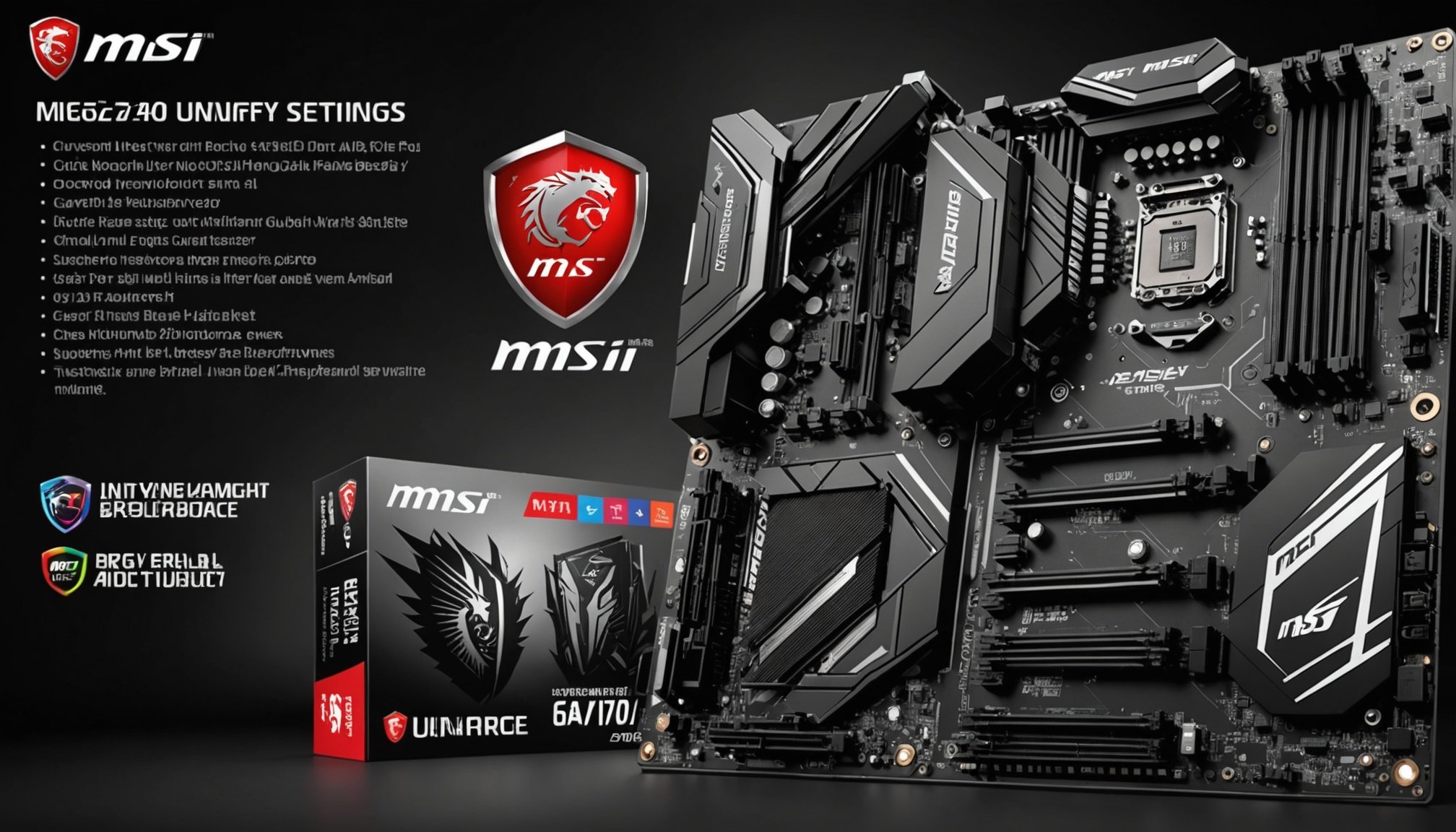Understanding BIOS Settings for the MSI MEG Z490 Unify Motherboard
In the realm of computer optimization, the BIOS settings play a vital role in shaping the overall system performance. For enthusiasts using the MSI MEG Z490 motherboard, understanding these nuances becomes essential. The BIOS serves as the firmware interface connecting your motherboard’s firmware to the operating system. Framed as the backbone of your system, proper BIOS configuration can unleash unseen potential in your hardware.
Properly configuring the BIOS settings on the MSI MEG Z490 Unify enables unparalleled motherboard optimization. This involves adjusting settings that cater to the unique architecture and capabilities of the MSI MEG Z490, ensuring you gain the maximum benefits from the board’s robust feature set. Key BIOS features specific to this motherboard include XMP profiles for memory overclocking, CPU Ratio adjustments for tailored processor performance, and voltage control settings that ensure a balanced power delivery.
For anyone seeking to attain peak performance from their MSI MEG Z490 Unify, an in-depth understanding of its BIOS settings is not just beneficial but crucial. With the right settings, users can experience improved stability, speed, and even longevity in their computing tasks, creating a satisfying and optimized computing experience.
Understanding BIOS Settings for the MSI MEG Z490 Unify Motherboard
Before diving into BIOS settings, it’s crucial to appreciate their role in system performance. BIOS, short for Basic Input/Output System, is essential for initializing hardware components and loading the operating system on startup. Properly configuring the BIOS settings on the MSI MEG Z490 motherboard is vital to optimizing your system. This optimization can lead to enhanced stability, speed, and efficiency.
The MSI MEG Z490 Unify motherboard boasts several key features that require attention for optimal performance. For instance, it supports overclocking capabilities through XMP profiles, which are crucial for stimulating your system’s RAM to operate at its highest capacity. Additionally, the BIOS menu offers options to tweak CPU ratios, allowing you to fine-tune processor operations matching your workload needs.
Adjusting voltage settings is another significant consideration. Precise voltage modifications can enhance stability, particularly when overclocking to prevent overheating and component stress. The motherboard’s BIOS settings further offer configurations for peripheral components, enabling tailored setup for a comprehensive range of hardware.
In summary, accurate BIOS settings adjustment is integral to unlocking the full potential of your MSI MEG Z490 Unify motherboard, ensuring a robust and efficient computing experience.
Understanding BIOS Settings for the MSI MEG Z490 Unify Motherboard
Before venturing into the intricate settings, it’s paramount to grasp the overarching role that BIOS settings play in a system’s performance. The BIOS is responsible for invaluable groundwork like hardware initialization and loading the operating system. For users of the MSI MEG Z490 motherboard, aligning these settings optimally is indispensable for achieving a superlative experience.
Critical features unique to the MSI MEG Z490 Unify are designed to bolster motherboard optimization. One such attribute is the XMP profiles. These profiles allow memory modules to operate at vastly enhanced frequencies, paving the way for boosted RAM throughput. Another prominent feature is the capability to tweak CPU ratios. This permits a finely-tuned processor performance tailored to specific workloads, thus vastly improving efficiency.
The importance of voltage control is equally noteworthy. Adjusting these settings accurately can greatly enhance stability, predominantly in overclocking scenarios, by preventing overheating and undue stress on vital components. The BIOS also allows configurations for peripheral devices, paving the way for personalized hardware setups.
Thus, mastering these specific BIOS features can significantly improve stability, speed, and longevity, offering a robust and optimized computing experience with the MSI MEG Z490 Unify.
Step-by-Step Guide to Optimal BIOS Settings
Embarking on the journey to achieve optimal BIOS settings on the MSI MEG Z490 Unify motherboard can significantly enhance system performance. It begins with accessing the BIOS setup interface, the command center where all crucial adjustments reside. Familiarity with navigation within this setup is key to unlocking the motherboard’s potential.
Accessing the BIOS Setup
To enter the BIOS, restart your computer and press the “Delete” key as the MSI logo appears. This will lead you to the BIOS interface, a hub of configurations that power your system.
Essential Configuration Settings
At this stage, some critical adjustments involve setting up RAM, CPU, and peripherals. Enabling XMP profiles under the Memory section allows RAM to run at advertised speeds, providing a noticeable performance boost. For the CPU, adjust the CPU Ratio to tailor processing power to your tasks, ensuring efficient utilization of your motherboard’s capabilities.
Advanced Tweaks for Performance
For those seeking further enhancement, tweak voltage settings for stability and peak performance. Proper voltage modifications can prevent issues like overheating, which are common in intensive computing tasks. Such tweaks play an influential role in performance enhancement, ensuring the system runs smoothly under substantial loads with optimal BIOS settings.
Explanation of Each BIOS Setting
Understanding the BIOS settings for the MSI MEG Z490 Unify is integral for maximizing performance. Let’s delve into the critical settings, their impacts, and recommended configurations.
XMP Profiles
XMP (Extreme Memory Profile) enables RAM to operate at specified high-performance speeds. Activating XMP profiles under Memory settings can unleash improved data flow and responsiveness, crucial for gaming or multitasking. Adjust your memory to the highest stable frequency as per the RAM specification to witness instantaneous performance benefits.
CPU Ratio
The CPU Ratio setting allows fine-tuning of the processor’s speed. By increasing the ratio, users can overclock their CPU for demanding tasks, boosting computing power. Carefully adjusting these settings provides tailored performance aligned with your workload needs, enhancing efficiency without overly stressing the CPU.
Voltage Control
Accurate voltage control is essential for maintaining system stability, especially when overclocking. Tuning the voltage ensures efficient power delivery and mitigates risks of overheating or instability. Set modest voltage gains to balance performance with reliability for sustained high-performance without excessive heat buildup.
In conclusion, these BIOS settings are pivotal in optimizing your MSI MEG Z490 Unify for different scenarios, offering precise control over your system’s capabilities. Adjusting the XMP profiles, CPU Ratio, and voltage control ensures your motherboard operates at its peak potential.
Benefits of Adjusting BIOS Settings
Adjusting the BIOS settings on your MSI MEG Z490 can result in substantial performance benefits, particularly for gaming enthusiasts and power users.
A primary benefit of BIOS adjustments is enhanced gaming performance. Fine-tuning settings like the CPU Ratio and enabling XMP profiles allows your system to handle high-demand games more efficiently by increasing processing speeds and memory throughput. This can translate into smoother graphics and faster frame rates, providing a more immersive gaming experience.
Another significant advantage is improved thermal management. By optimizing voltage settings and CPU power controls, you can manage heat generation better, which in turn prevents your system from overheating. This ensures not only more efficient operation but also prolongs the lifespan of your components by reducing wear and tear.
Moreover, such optimizations contribute to overall system stability and reliability during high-performance tasks. Whether running intensive software or multitasking, these BIOS tweaks can keep your system performing optimally without unexpected crashes or slowdowns.
Adjusting BIOS settings is a vital step in ensuring your MSI MEG Z490 motherboard operates at its fullest potential, delivering enhanced performance and stability for a variety of demanding applications.
Benefits of Adjusting BIOS Settings
Adjusting the BIOS settings on the MSI MEG Z490 Unify motherboard can unlock significant performance benefits, particularly in gaming and high-performance applications. Through careful BIOS adjustments, users can achieve results that elevate their computing experience.
Enhanced Gaming Performance: By tweaking settings such as XMP profiles and CPU ratio, gamers can enjoy higher frame rates and smoother gameplay. These adjustments allow the system to harness additional processing power and memory bandwidth, making demanding games run more fluidly.
Improved Thermal Management and Efficiency: Proper optimization of BIOS settings contributes to better thermal management. By configuring voltage control and fan settings, the motherboard can achieve a balanced and efficient thermal profile. This not only protects components from overheating but also enhances energy efficiency.
Stability and Reliability in High-Performance Tasks: Adjustments in BIOS settings lead to greater system stability during intensive tasks. Configurations like voltage tuning ensure consistent power delivery, which eradicates risk factors like crashes or hardware failures during prolonged high processing activities.
These optimization outcomes testify to the wide-ranging advantages of tailoring BIOS settings. Through methodical adjustments, users can significantly enhance the functionality and longevity of the MSI MEG Z490 Unify motherboard.
Troubleshooting BIOS Modifications
Adjusting BIOS settings on your MSI MEG Z490 can occasionally lead to unexpected challenges. Here’s how to troubleshoot and recover effectively.
Common Problems and Solutions
Encountering issues with BIOS settings is not uncommon. Problems may include system instability, failed startups, or hardware failures. Begin by identifying if errors correlate with recent adjustments. For example, an overclocked CPU ratio might trigger overheating, causing shutdowns. Reverting these changes or lowering settings can often resolve such issues.
Safe Recovery Options
Should you face persistent problems, consider reverting to default BIOS settings. This can typically be done by selecting the “Load Optimized Defaults” option within the BIOS menu. This action will reset all settings to factory defaults, offering a clean slate to diagnose errors without hardware risks.
Best Practices for BIOS Changes
When modulating BIOS settings, best practices include making incremental adjustments and documenting changes for easy backtracking. Ensure your BIOS is updated to the latest firmware version for enhanced compatibility and feature sets. It’s prudent to use stress-testing tools post-adjustment to verify stability, especially after modifications like voltage tweaks or CPU overclocking.
Troubleshooting BIOS Modifications
Adjusting BIOS settings on your MSI MEG Z490 motherboard can deliver substantial performance benefits. However, it also comes with a risk of encountering issues. Knowing how to troubleshoot potential problems is crucial for a smooth and successful modification process.
Common Problems and Solutions
BIOS adjustments can lead to instability or boot failures. A common issue might be the system failing to boot after overclocking through CPU ratios or XMP profiles. The first step in resolving this is to reset the BIOS to default. You can achieve this by accessing the BIOS menu and selecting the “Load Default Settings” option, or by using the CMOS reset jumper on the motherboard if direct access isn’t possible.
Safe Recovery Options
When a system fails to boot, employ safe recovery methods like the BIOS Flashback feature, allowing a BIOS rewrite even without a CPU or memory. This MSI feature is especially useful for recovering from corrupted updates. Always ensure to have an updated BIOS version stored on a USB drive.
Best Practices for BIOS Changes
Adopting cautious practices while altering BIOS settings is vital. Checklist items include saving existing configurations before changes, adjusting one setting at a time, and keeping track of modifications. These measures help revert to previous stable setups if complications arise, ensuring a secure optimization journey.











